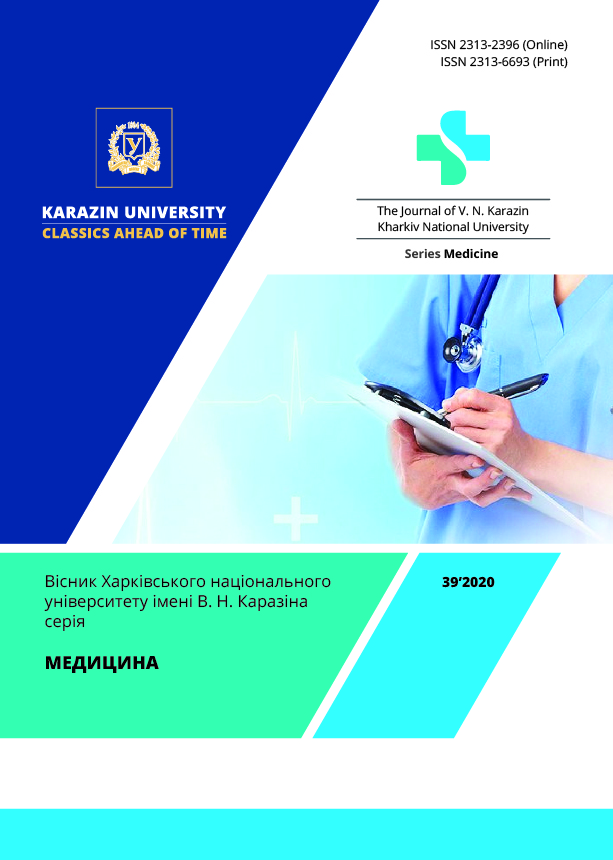Characteristic of acute illness of higher education students
Abstract
Abstract. The problem of student health has become of great importance in recent decades and remains unresolved at the current time. The article presents the data of the study of acute morbidity of students of higher educational establishments, its frequency and structure, the gender peculiarities and the state of resistance of their organism are analyzed. Highlighted the priority diseases groups, their specificity and differences. According to the results of the study, the state of adaptation of the students' body in the first year of study was revealed. At the same time, there are signs of tension and breakdown of these mechanisms, decrease in body resistance may be primarily due to sudden changes in the habitual environment of students, impaired diet and quality of work-rest cycle, the presence of a large number of students who have bad habits, constant increase of educational and information load in the present conditions. Only 18.46 ± 1.16 % of medical high schools and even fewer students of technical high schools have 7.81 ± 0.63 % satisfactory indicators of resistance to the body, which indicates a possible discrepancy between the impact of the educational complex and external factors to the adaptive capacity of the student body. In the structure of acute morbidity prevail respiratory diseases in both study groups (KhNMU − 80.16 ± 2.58 %, KhNURE − 80.37 ± 2.61 %). Also, quite a large part was taken by diseases of the digestive system and urogenital system. Students of a technical university had worse indicators of body resistance compared to students of a medical university. It was also found that boys had poorer body resistance compared to girls in all groups. In future all this has negative social and economic consequences for the country as a whole.
Downloads
References
Chernyavska, L. (2017). Stan zdorovya studentiv, problemy ta shlyakhy yikh vyrishennya [Students’ health, problems and solutions]. In Medsestrynstvo, 1, 24–27 [in Ukrainian].
Namazi, A. (2015). The correlation between general health, emotional intelligence and academic achievement together on midwifery students. In J Clin Nurs Midwifery, 4, 20-8.
Yeremenko, N. (2019). Suchasni pidkhody do formuvannya kul’tury zdorov’ya studentiv v protsesi fizychnoho vykhovannya [Modern approaches to the formation of student health culture in the process of physical education]. In Fizychna kul’tura, sport ta zdorov’ya natsiyi : zb. nauk. Prats’, 7 (26), 57–63 [in Ukrainian].
Iarmak, O. (2015). Analiz zakhvoriuvanosti studentskoi molodi Bilotserkivskoho natsionalnoho ahrarnoho universytetu [Analysis of the incidence of student youth of Bila Tserkva National Agrarian University]. In Fizychne vykhovann iai sport, 18, 56–59 [in Ukrainian].
Sorokolit, N. (2019). Monitorynh stanu zdorov’ya studentiv I-II kursiv [Monitoring the health of first− and second−year students]. In Naukovo-pedahohichni problemy fizychnoyi kul’tury (fizychna kul’tura i sport), 533–538 [in Ukrainian].
Futornyi, S. (2013). Kharakterystyka stanu zdorovia studentiv vyshchykh navchalnykh zakladiv [Characteristics of the state of health of students of higher educational institutions]. In Teoriia i metodyka fizychnoho vykhovannia i sportu, 2, 99–105 [in Ukrainian].
Maksymova, K. (2017). Monitorynh stanu somatychnoho zdorovia studentok i kursiv vyshchykh navchalnykh zakladiv m. Kharkova [Monitoring the state of physical health of students and courses of higher educational institutions in Kharkiv]. In Mizhnarodnyi naukovyi zhurnal «Internauka», 7 (29), 30–34 [in Ukrainian].
Kuidina, T. (2015). Monitorynh fizychnoho ta psykhichnoho zdorovia studentiv pershoho kursu klasychnoho universytetu [Monitoring the physical and mental health of first-year students of the classical university]. In Mizhnarodni konferentsii: Bezpeka liudyny u suchasnykh umovakh No − NTU «KhPI», 147–150 [in Ukrainian].
Tovkun, L. (2017). Otsinka rivnya somatychnoho zdorov’ya studentiv Pereyaslav-Khmel’nytskoho derzhavnoho pedahohichnoho universytetu imeni Hryhoriya Skovorody [Assessment of the level of somatic health of students of Pereyaslav-Khmelnytsky State Pedagogical University named after Hryhoriy Skovoroda.]. In Molodyy vchenyy, 9.1 (49.1), 167–170 [in Ukrainian].
Kawyannejad, R., Mirzaei, M., Valinejadi, A. (2019). [General health of students of medical sciences and its relation to sleep quality, cell phone overuse, social networks and internet addiction]. In BioPsychoSocial Med, 13. DOI: 10.1186/s13030-019-0150-7
Gomez-Pinilla, F. (2008). [The influences of diet and exercise on mental health through hormesis]. In Ageing Research Reviews, 7, 1, 49–62.
Cockerham, W. (2006). [Psychological distress, gender, and health lifestyles in Belarus, Kazakhstan, Russia, and Ukraine]. In Social Science & Medicine, 63, 11, 2381–2394
The Journal of V. N. Karazin Kharkiv National University, series Medicine has following copyright terms:
- Authors retain copyright and grant the journal right of first publication with the work simultaneously licensed under a Creative Commons Attribution License that allows others to share the work with an acknowledgement of the work’s authorship and initial publication in this journal.
- Authors are able to enter into separate, additional contractual arrangements for the non-exclusive distribution of the journal’s published version of the work, with an acknowledgement of its initial publication in this journal.
- Authors are permitted and encouraged to post their work online prior to and during the submission process, as it can lead to productive exchanges, as well as earlier and greater citation of published work.




